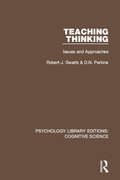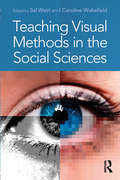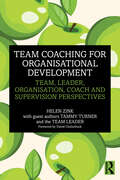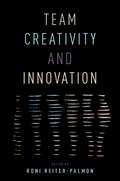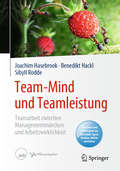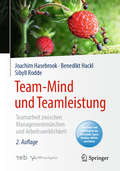- Table View
- List View
Teaching Thinking: Issues and Approaches (Psychology Library Editions: Cognitive Science)
by Robert J. Swartz D.N. PerkinsOriginally published in 1990, this title attempts to provide for the educational practitioner an overview of a field that responded in the 1980s to a major educational agenda. This innovative ‘agenda’ called for teaching students in ways that dramatically improved the quality of their thinking. Its context is a variety of changes in education that brought the explicit teaching of thinking to the consciousness of more and more teachers and administrators.
Teaching Thinking: Issues and Approaches (Psychology Library Editions: Cognitive Science)
by Robert J. Swartz D.N. PerkinsOriginally published in 1990, this title attempts to provide for the educational practitioner an overview of a field that responded in the 1980s to a major educational agenda. This innovative ‘agenda’ called for teaching students in ways that dramatically improved the quality of their thinking. Its context is a variety of changes in education that brought the explicit teaching of thinking to the consciousness of more and more teachers and administrators.
Teaching Tough Kids: Simple and Proven Strategies for Student Success
by Mark Le MessurierHow can you really make a difference for your students? Teaching Tough Kids delivers a refreshing collection of realistic ideas to sustain the organisational and behavioural transformations of all students, particularly those who 'do it tough'; who learn and react differently. They are complex kids who find life tougher than most. Managing their emotion and behaviour presents educators with a spectacular challenge in schools today, and numbers are on the rise. Filled with inspirational case studies, this book focuses on building improved relationships, structures and behaviours, rather than seeing the student as 'the problem' that must be fixed. Highlighting the value of promoting positive connections with students of all ages, the author presents ways to incorporate inclusive ideas into everyday practice and construct pathways for students to become engaged in their learning and achieve success. This stimulating book shows teachers how to: build student connectedness to learning; set achievable goals for each individual child; support emotional stability; strengthen organisation patterns; address behavioural issues; improve homework planning; create friendships and deal with bullying. Teaching Tough Kids takes a particularly close focus on students identified with Learning Disability, Attention Deficit Disorder, Attention Deficit Hyperactivity Disorder, Oppositional Defiant Disorder and Asperger Syndrome. Another group of students with executive functioning difficulties are emerging in schools. These are the kids who have endured neglect or too much stress and uncertainty in their lives and as a result display classic symptoms of hyperactivity, hyper vigilance and impulsivity. Teaching Tough Kids will be of immense interest to teachers, student teachers, staff in Pupil Referral Units, SENCos and all those involved with Behaviour Support work.
Teaching Tough Kids: Simple and Proven Strategies for Student Success
by Mark Le MessurierHow can you really make a difference for your students? Teaching Tough Kids delivers a refreshing collection of realistic ideas to sustain the organisational and behavioural transformations of all students, particularly those who 'do it tough'; who learn and react differently. They are complex kids who find life tougher than most. Managing their emotion and behaviour presents educators with a spectacular challenge in schools today, and numbers are on the rise. Filled with inspirational case studies, this book focuses on building improved relationships, structures and behaviours, rather than seeing the student as 'the problem' that must be fixed. Highlighting the value of promoting positive connections with students of all ages, the author presents ways to incorporate inclusive ideas into everyday practice and construct pathways for students to become engaged in their learning and achieve success. This stimulating book shows teachers how to: build student connectedness to learning; set achievable goals for each individual child; support emotional stability; strengthen organisation patterns; address behavioural issues; improve homework planning; create friendships and deal with bullying. Teaching Tough Kids takes a particularly close focus on students identified with Learning Disability, Attention Deficit Disorder, Attention Deficit Hyperactivity Disorder, Oppositional Defiant Disorder and Asperger Syndrome. Another group of students with executive functioning difficulties are emerging in schools. These are the kids who have endured neglect or too much stress and uncertainty in their lives and as a result display classic symptoms of hyperactivity, hyper vigilance and impulsivity. Teaching Tough Kids will be of immense interest to teachers, student teachers, staff in Pupil Referral Units, SENCos and all those involved with Behaviour Support work.
Teaching Undergraduates (Educational Psychology Series)
by Roger L. DominowskiThis practical guide is designed to help college teachers plan their undergraduate courses and deliver high-quality instruction. The book's theme is that teaching is a creative, decision-making, idea-testing enterprise whose purpose is to facilitate student learning in all of its facets. Its goal is to help instructors understand the multiple kinds of learning taking place in their courses so that they can select, devise, evaluate, and modify teaching techniques to improve their effectiveness. Based on research on human learning, memory, thinking, and problem solving, as well as studies of teaching and less-formal reports of teaching practices, the book offers concrete advice about all aspects of college teaching. *Part I is devoted to course planning. It outlines the many decisions instructors face in defining a course as their own and discusses the larger issues that shape a course and constrain some specific choices. Selecting course content, choosing learning goals, deciding how to pace a course, and scheduling tests are some of these issues. A workable timetable for preparing a course is included. *Part II is a mini-course on human learning, memory, and thinking. It provides the conceptual foundation for making teaching decisions, for selecting instructional strategies, and especially for inventing new techniques that might particularly fit a specific course. *Part III deals with the "nitty-gritty" of college teaching, including how to choose a textbook; lecturing and conducting classroom discussions; types and purposes of writing assignments, and how to structure and evaluate them; dealing with plagiarism; strengths and weaknesses of different types of tests, the relation of tests to learning goals, and guidelines for constructing good tests; and grading systems. *Part IV addresses professional and ethical issues of importance and consequence to instructors. New college instructors, more experienced faculty who would like to reflect on their teaching practices and consider making some changes, and teaching assistants will all find this book relevant and useful.
Teaching Undergraduates (Educational Psychology Series)
by Roger L. DominowskiThis practical guide is designed to help college teachers plan their undergraduate courses and deliver high-quality instruction. The book's theme is that teaching is a creative, decision-making, idea-testing enterprise whose purpose is to facilitate student learning in all of its facets. Its goal is to help instructors understand the multiple kinds of learning taking place in their courses so that they can select, devise, evaluate, and modify teaching techniques to improve their effectiveness. Based on research on human learning, memory, thinking, and problem solving, as well as studies of teaching and less-formal reports of teaching practices, the book offers concrete advice about all aspects of college teaching. *Part I is devoted to course planning. It outlines the many decisions instructors face in defining a course as their own and discusses the larger issues that shape a course and constrain some specific choices. Selecting course content, choosing learning goals, deciding how to pace a course, and scheduling tests are some of these issues. A workable timetable for preparing a course is included. *Part II is a mini-course on human learning, memory, and thinking. It provides the conceptual foundation for making teaching decisions, for selecting instructional strategies, and especially for inventing new techniques that might particularly fit a specific course. *Part III deals with the "nitty-gritty" of college teaching, including how to choose a textbook; lecturing and conducting classroom discussions; types and purposes of writing assignments, and how to structure and evaluate them; dealing with plagiarism; strengths and weaknesses of different types of tests, the relation of tests to learning goals, and guidelines for constructing good tests; and grading systems. *Part IV addresses professional and ethical issues of importance and consequence to instructors. New college instructors, more experienced faculty who would like to reflect on their teaching practices and consider making some changes, and teaching assistants will all find this book relevant and useful.
Teaching Visual Methods in the Social Sciences
by Caroline Wakefield Sal WattTeaching Visual Methods in the Social Sciences presents a practical and theoretical framework for those wanting to introduce visual methods into their curricula. Drawing on the expertise of contributors from across the social sciences, the book provides a comprehensive introduction to visual methodology, learning and teaching theory, and the ethical considerations involved. Divided into three parts, the book begins with an overview of how visual methods have been used in academic research, and how this can be applied to teaching and pedagogy. It then goes on to introduce different methods, including photography, film and drawing, describing how they can be used in various locations. Finally, the book pulls everything together, advocating the wider use of teaching visual methods in further and higher education curricula across the social science subjects. The book features a plethora of examples, as well as practical resources for FE and HE teachers, making it an essential companion for anyone interested in utilising visual methods in their teaching.
Teaching Visual Methods in the Social Sciences
by Caroline Wakefield Sal WattTeaching Visual Methods in the Social Sciences presents a practical and theoretical framework for those wanting to introduce visual methods into their curricula. Drawing on the expertise of contributors from across the social sciences, the book provides a comprehensive introduction to visual methodology, learning and teaching theory, and the ethical considerations involved. Divided into three parts, the book begins with an overview of how visual methods have been used in academic research, and how this can be applied to teaching and pedagogy. It then goes on to introduce different methods, including photography, film and drawing, describing how they can be used in various locations. Finally, the book pulls everything together, advocating the wider use of teaching visual methods in further and higher education curricula across the social science subjects. The book features a plethora of examples, as well as practical resources for FE and HE teachers, making it an essential companion for anyone interested in utilising visual methods in their teaching.
Teaching with a Strength-Based Approach: How to Motivate Students and Build Relationships
by Steven BaronHelping students improve doesn't have to mean remediating their deficits. In this important book, Steven Baron shows the benefits of a strength-based approach that instead emphasizes students' assets and capabilities, making them feel more connected to teachers and peers and more engaged in learning. You’ll learn practical, research-backed ways to help students of all grade levels identify and celebrate their strengths, develop self-confidence and a growth mindset, build intrinsic motivation, overcome a fear of making mistakes, manage their feelings, focus on gratitude, and more. You’ll also discover ways to create a more strength-based Individual Education Plan (IEP), increase your own resilience as a teacher, and build a strength-based culture throughout your school and district. The appendix provides a variety of exercises you can use to help students focus on their strengths, foster kindness, and understand the impact of bullying. Students spend approximately 1300 hours during the year with teachers; this resource will help you make this time as affirming as possible so students are ready to learn and grow.
Teaching with a Strength-Based Approach: How to Motivate Students and Build Relationships
by Steven BaronHelping students improve doesn't have to mean remediating their deficits. In this important book, Steven Baron shows the benefits of a strength-based approach that instead emphasizes students' assets and capabilities, making them feel more connected to teachers and peers and more engaged in learning. You’ll learn practical, research-backed ways to help students of all grade levels identify and celebrate their strengths, develop self-confidence and a growth mindset, build intrinsic motivation, overcome a fear of making mistakes, manage their feelings, focus on gratitude, and more. You’ll also discover ways to create a more strength-based Individual Education Plan (IEP), increase your own resilience as a teacher, and build a strength-based culture throughout your school and district. The appendix provides a variety of exercises you can use to help students focus on their strengths, foster kindness, and understand the impact of bullying. Students spend approximately 1300 hours during the year with teachers; this resource will help you make this time as affirming as possible so students are ready to learn and grow.
Teaching with Books that Heal: Authentic Literature and Literacy Strategies to Help Children Cope with Everyday Problems
by Patricia L. Kolencik Carianne BernadowskiHelp children learn coping skills through literature! This book answers the often repeated question: Is there a children's book I can read in my classroom to give children insight into significant life events? Literature ideas and activities help students cope with real-life situations, such as bullying, that interfere with school. This book will assist educators in guiding and nurturing children's special issues and concerns with outstanding, ready-to-go reading and writing lessons. This professional resource for K-6 educators and parents uses literature with identifiable characters to help children who are facing challenges in their lives. Like bullying, peer acceptance, peer pressure, and being different, as well as family situations such as death, divorce, adoption, and sibling rivalry.
Teaching with Sociological Imagination in Higher and Further Education: Contexts, Pedagogies, Reflections
by Christopher R. Matthews Ursula Edgington Alex ChannonThis book uses research and personal stories from university lecturers to explore pedagogical strategies that illuminate how students’ minds can be ‘switched on’ in order to unlock their extraordinary potential. It presents diverse ways to create inspiring learning environments, in chapters written by internationally respected experts in the broad field of the social sciences. Each author illustrates how – through their unique teaching philosophies and practices – they seek to enhance students’ experiences and promote their critical thinking, learning and development. The respective chapters provide conceptual arguments, personal insights and practical examples from a broad range of classrooms, demonstrating various ways in which students’ sociological imagination can be brought to life. As such, the book is both practical and theoretical, and is primarily aimed at educators working in both higher and further education institutions who wish to develop their understanding of classroom pedagogy as well as gain practical ideas for teaching and learning in the social sciences.
Teaching Writing in Chinese Speaking Areas (Studies in Writing #16)
by Mark Shiu-Kee Shum De-Lu ZhangOne of the most civilized nations in history, China has a long-standing writing tradition and many Chinese texts have become world treasures. However, the way the Chinese teach writing in various countries in contemporary times is little known to the outside world, especially in Western countries. Undoubtedly, the Chinese have had an established traditional method of writing instruction. However, recent social and political developments have created the perception amongst both practitioners and researchers of a need for change. Whilst certain socio-political changes, both in Mainland China and in the territories, acted as agents for reform of the teaching of composition, the shape these reforms are taking has been due to many different influences, coming both from inside the countries themselves and from foreign sources. Mainland China, Hong Kong, Taiwan and Singapore have each developed their own approach to the teaching of composition.
Teaching Your Child with Love and Skill: A Guide for Parents and Other Educators of Children with Autism, including Moderate to Severe Autism
by Joyce ShowParents of children with autism can often feel out of their depth when it comes to nurturing their child's learning and development. This book helps parents to make sense of the baffling array of educational interventions available, showing how to adapt different strategies to meet the specific needs of their child, including those with moderate to severe autism. Guided by love, faith and unwavering resolve, Joyce Show offers practical advice based on her experiences as both a mother and a physician. She takes the reader by the hand through all the steps of cognitive, social, and emotional development from initial engagement to abstract thinking, and provides straightforward primers for popular interventions such as Floortime and Applied Behavior Analysis (ABA). Parents will learn how to motivate play, build up communication, deal with challenging behaviors, and teach important everyday life skills, while growing in a trusting relationship with their child. This book offers encouragement and guidance to the parents of any child on the autism spectrum whether high or low functioning, as well as the teachers, therapists, family members, and friends who support them.
Teaching Your Child with Love and Skill: A Guide for Parents and Other Educators of Children with Autism, including Moderate to Severe Autism (PDF)
by Joyce ShowParents of children with autism can often feel out of their depth when it comes to nurturing their child's learning and development. This book helps parents to make sense of the baffling array of educational interventions available, showing how to adapt different strategies to meet the specific needs of their child, including those with moderate to severe autism. Guided by love, faith and unwavering resolve, Joyce Show offers practical advice based on her experiences as both a mother and a physician. She takes the reader by the hand through all the steps of cognitive, social, and emotional development from initial engagement to abstract thinking, and provides straightforward primers for popular interventions such as Floortime and Applied Behavior Analysis (ABA). Parents will learn how to motivate play, build up communication, deal with challenging behaviors, and teach important everyday life skills, while growing in a trusting relationship with their child. This book offers encouragement and guidance to the parents of any child on the autism spectrum whether high or low functioning, as well as the teachers, therapists, family members, and friends who support them.
Team-Based Collaboration in Higher Education Learning and Teaching: A Review of the Literature (SpringerBriefs in Education)
by Catherine Newell Alan BainThis book examines what collaboration means in practice, and the factors that enable effective team collaboration for learning and teaching in higher education. It explains how academics can work more collaboratively, and how universities can organise and govern themselves by means of collaboration. The book brings together current research and commentaries on collaboration in higher education to provide important guidance derived from a synthesis and evaluation of the existing empirical research and commentaries in the field.The book will benefit all readers who are interested in making their own teams and higher education organisations more collaborative. It will help them plan collaborative innovations in their organisations, identify priorities for professional capacity building, and design collaborative organisational structures.
Team-Based Shared Formulation for Psychosis: The SAFE Approach
by Alan Meaden Andrew Fox Henna HussainAdding to the growing literature on shared formulation, the authors provide over two decades of practice-based evidence for the use of a Shared Assessment, Formulation and Education (SAFE) approach to working with those with complex mental health and behavioural needs. The SAFE approach offers an evidence-informed framework for multidisciplinary teams to address the needs of those with complex and enduring psychosis for whom current evidence-based interventions are ineffective in promoting their recovery. Drawing from richly detailed case studies, the authors provide a range of useful tools and fomulation templates for use by clinicans and professionals alike. They put forward a shared language to promote a multidisciplinary understanding of service users' complex needs and a means of organising treatment into a focused, realistic and targeted approach aimed at reducing barriers to recovery and allowing individuals to lead personally meaningful lives. The book focuses predominantly on the treatment of those with psychosis who require bespoke, multi-theory informed care. This work will be an invaluable resource to professionals working with this client group, including clinical and counselling psychologists, psychiatrists and other allied health professionals.
Team-Based Shared Formulation for Psychosis: The SAFE Approach
by Alan Meaden Andrew Fox Henna HussainAdding to the growing literature on shared formulation, the authors provide over two decades of practice-based evidence for the use of a Shared Assessment, Formulation and Education (SAFE) approach to working with those with complex mental health and behavioural needs. The SAFE approach offers an evidence-informed framework for multidisciplinary teams to address the needs of those with complex and enduring psychosis for whom current evidence-based interventions are ineffective in promoting their recovery. Drawing from richly detailed case studies, the authors provide a range of useful tools and fomulation templates for use by clinicans and professionals alike. They put forward a shared language to promote a multidisciplinary understanding of service users' complex needs and a means of organising treatment into a focused, realistic and targeted approach aimed at reducing barriers to recovery and allowing individuals to lead personally meaningful lives. The book focuses predominantly on the treatment of those with psychosis who require bespoke, multi-theory informed care. This work will be an invaluable resource to professionals working with this client group, including clinical and counselling psychologists, psychiatrists and other allied health professionals.
Team Coaching for Organisational Development: Team, Leader, Organisation, Coach and Supervision Perspectives
by Helen ZinkWorking with teams, leading teams and being a member of a team is part of everyday working life for most of us. Through the lens of a team coaching case study, this book considers the development journey of a team and system influences over a three-year period. Readers are invited to walk in the shoes of the team, the team leader, the organisation, the team coach and the coach’s supervision and support networks, providing a unique insight into team coaching and development that goes beyond the traditional focus on the coach’s perspective. Helen Zink uses her considerable experience as a leadership and team growth coach, and leader to illustrate how team coaching interventions can be combined with other disciplines such as positive psychology, change management and strategic implementation in effective ways. The book takes a pracademic approach, showing how theories, models and best practice are applied to a real case and highlighting both the successes and challenges experienced to offer an example for all those involved in team, leadership and organisational development. With it widely recognised that collective leadership and teamwork is needed to deal with the rapidly changing environment organisations find themselves in, this is a timely and important resource for coaches, team coaches, coach supervisors, team leaders, team members, organisational development specialists, change managers, academics and consultants.
Team Coaching for Organisational Development: Team, Leader, Organisation, Coach and Supervision Perspectives
by Helen ZinkWorking with teams, leading teams and being a member of a team is part of everyday working life for most of us. Through the lens of a team coaching case study, this book considers the development journey of a team and system influences over a three-year period. Readers are invited to walk in the shoes of the team, the team leader, the organisation, the team coach and the coach’s supervision and support networks, providing a unique insight into team coaching and development that goes beyond the traditional focus on the coach’s perspective. Helen Zink uses her considerable experience as a leadership and team growth coach, and leader to illustrate how team coaching interventions can be combined with other disciplines such as positive psychology, change management and strategic implementation in effective ways. The book takes a pracademic approach, showing how theories, models and best practice are applied to a real case and highlighting both the successes and challenges experienced to offer an example for all those involved in team, leadership and organisational development. With it widely recognised that collective leadership and teamwork is needed to deal with the rapidly changing environment organisations find themselves in, this is a timely and important resource for coaches, team coaches, coach supervisors, team leaders, team members, organisational development specialists, change managers, academics and consultants.
Team Creativity and Innovation
by Roni Reiter-PalmonFor the past two decades, creativity and innovation have been viewed by researchers as critical to organizational success and survival. Understanding the factors that facilitate or inhibit creativity and innovation at the individual level has been the focus of much of the research in this area. However, while earlier work on teams considered the working dynamics of the group as a context variable with individual creativity the outcome, research now emphasizes group creativity as the intended, desired outcome. This shift in thought has occurred because many of the problems routinely facing organizations are complex and cannot be solved by a single individual at the helm. Edited by Roni Reiter-Palmon, Team Creativity and Innovation provides readers with a state-of-the-art review of the major concepts and current research related to the demonstrable benefits of team creativity and innovation. In this volume, Reiter-Palmon and contributors explore such topics as team collaboration and communication, trust and psychological safety, team diversity, social networks, conflict, organizational learning, and more as a way to introduce readers to the issues that matter most in today's modern, forward-thinking workplace.
Team Creativity and Innovation
For the past two decades, creativity and innovation have been viewed by researchers as critical to organizational success and survival. Understanding the factors that facilitate or inhibit creativity and innovation at the individual level has been the focus of much of the research in this area. However, while earlier work on teams considered the working dynamics of the group as a context variable with individual creativity the outcome, research now emphasizes group creativity as the intended, desired outcome. This shift in thought has occurred because many of the problems routinely facing organizations are complex and cannot be solved by a single individual at the helm. Edited by Roni Reiter-Palmon, Team Creativity and Innovation provides readers with a state-of-the-art review of the major concepts and current research related to the demonstrable benefits of team creativity and innovation. In this volume, Reiter-Palmon and contributors explore such topics as team collaboration and communication, trust and psychological safety, team diversity, social networks, conflict, organizational learning, and more as a way to introduce readers to the issues that matter most in today's modern, forward-thinking workplace.
Team Flow: The psychology of optimal collaboration (SpringerBriefs in Well-Being and Quality of Life Research)
by Jef J.J. van den Hout Orin C. DavisThis book presents a series of studies that conceptualize, test, and monitor team flow experiences in professional organizations to perform autonomously and successfully. It analyses the processes by which team flow emerges by exemplifying case studies, and introduces a protocol to spark team flow in professional organizations.
Team-Mind und Teamleistung: Teamarbeit zwischen Managementmärchen und Arbeitswirklichkeit
by Joachim Hasebrook Benedikt Hackl Sibyll RoddeWie können Teams den Erfolg von Organisationen steigern?Wann schaffen Mitarbeiter in Teams wirklich mehr als alleine? Entscheiden Teams ausgewogener als Einzelne?Führt eine gute Teamatmosphäre wirklich zu mehr Leistung?Können Roboter und Künstliche Intelligenz zu Teamkollegen werden?Aus der Wissenschaft für die Praxis gibt dieses inhaltlich breit aufgestellte Buch fundierte, richtungsweisende und praxisnahe Antworten auf Fragen zum Thema „Team“. Basierend auf aktuellen Erkenntnissen der Sozial-, Arbeits- und Neuropsychologie zeigen die Autoren an vielen praxisrelevanten Beispielen und anhand von Interviews mit erfahrenen Managern aus Spitzensport, Wirtschaft, Militär und Wissenschaft, wie Teamführung in Organisationen sinnvoll umgesetzt wird und Teams erfolgreich agieren können.Erfahren Sie, wie auch Sie in Ihrer Organisation oder in Ihrem Team die gesamte Teamleistung dauerhaft steigern können.Zielgruppen:Alle, die selbst in Teams arbeiten, z. B. Teamleiter in Dienstleistung, Verwaltung oder IndustrieMitarbeiter in teamorientierten Organisationen Vorstände und AufsichtsräteManager und TeamverantwortlicheAlle, die Voraussetzungen für Teamarbeit verbessern wollen, z. B. Strategie- und ManagementberaterIngenieure für im Team verwendete MaschinenArchitekten von ArbeitsräumenDesigner von ArbeitsumgebungenForscher an Hochschulen und in Unternehmen
Team-Mind und Teamleistung: Teamarbeit zwischen Managementmärchen und Arbeitswirklichkeit
by Joachim Hasebrook Benedikt Hackl Sibyll RoddeWie erfolgreich eine Organisation ist, wird dadurch bestimmt, wie gut die Mitarbeitenden in ihr zusammenarbeiten. Krisenzeiten machen das besonders deutlich und stellen zugleich besondere Anforderungen an die Zusammenarbeit: Krisenstäbe werden gebildet, Teammitglieder arbeiten plötzlich getrennt und virtuell, Unsicherheit durch psychische Belastungen und Cyberattacken wächst. Jenseits von Binsenwahrheiten und simplen Erfolgsrezepten gibt dieses Managementbuch psychologisch und betriebswirtschaftlich fundiert Antworten, wie erfolgreiche Teamarbeit auch in Krisenzeiten funktioniert. Sie erfahren, wie Sie Teamleistungen fördern und was Sie von Hochleistungsteams lernen können. Mit zahlreichen Beispielen aus der Praxis und in Interviews führender Expertinnen und Experten aus Industrie, Wissenschaft, Medizin, Militär und Spitzensport wird leicht verständlich und unterhaltsam erläutert, wie man Trendsetter für bessere Teamleistung wird. Das Buch ist von einem Organisationspsychologen, einem Betriebswirt und einer klinischen Psychologin verfasst und daher interdisziplinär und breit anwendbar angelegt. Es beruht auf über 15 Jahren Praxis- und Forschungserfahrung sowie topaktuellen Erkenntnissen der Sozial-, Arbeits- und Neuropsychologie. Das Buch wendet sich an alle, die in Entscheidungsgremien, Entwicklungs- und Produktionsteams oder in der Teamleitung arbeiten. Es ist auch wertvoll für Teamtrainer, Coaches, Berater sowie Designer und Architekten, die Teamarbeitsplätze entwickeln.
